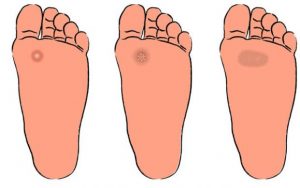Usually, in dermatology clinics, I often encounter patients who come to see podiatry. Most patients can’t distinguish whether they have corns (commonly known as “foot spikes”) or plantar warts (commonly known as “thorns or warts”) and calluses (commonly known as “calluses”). Some dermatologists are also in the cloud. Patients often mistake the three for “corns”. As human beings progress, they gradually break away from manual labor and walk for a long time. Clinically, it is true. Corns are already very rare, so I took time today to take everyone to get a comprehensive understanding of these three, so as not to spread the crown and lead to misdiagnosis and mistreatment.

1. Corns
It is a limited conical keratinous growth caused by chronic friction or pressure. The tip is deep into the skin and the base is exposed on the surface of the skin. It is round like corns, hence its name. The color is light or dark yellow, and the surface is smooth and skinny. Wrinkles are slightly transparent and have clear boundaries. Pressing the top will cause pain due to the tip oppressing the subcutaneous nerve. Most patients come to see a doctor because of the pain that affects walking and work. They are more likely to occur in areas that are prone to friction such as hands and feet, or between fingers or toes. Occurrence, rarely more than 3, is not contagious, and individual patients will not be treated and will heal and subside after the external force is removed.
2. Plantar warts
It is caused by human papillomavirus (HPV) type 1. It is transmitted through direct or indirect contact. Pathogenesis is related to the skin wounds caused by trauma and the individual’s immune status. People with abnormal or weak immune function are more likely to be infected. Early skin color papules, which gradually develop into round gray-yellow spots with rough and uneven surfaces (generally not become “cauliflower-like” due to plantar pressure), the skin lines are not obvious or damaged, the boundaries are clear, and the surrounding area Slightly thickened horny ring, with small black spots and or bleeding points after the wart body surface is cut off or the wart body is broken. Generally, it is not painful, and some patients have slight pain; it is infectious, large in number, rarely single, and feet It can appear in various parts, and most of them are first on one foot or only on one foot.

3. Callus
It is a light yellow flat keratinocyte hyperplastic plaque formed by long-term compression or friction stimulation, with thin edges, thick middle, round-like, large area, individual patches or strips, slightly transparent, generally, no sensation, Individual patients are accompanied by chapped, pain, and/or tenderness that is not obvious, and it is more common in the frictional parts of the bone protrusions. It is more common in patients with foot deformities, long-term sports friction, or inappropriate shoes, and those who love to wear high heels. Not contagious.
4. How to identify the three?
The corpus callosum is relatively simple, with large light yellow patches appearing on the rubbing site. The diagnosis can be confirmed by combining the clinical symptoms and picture comparison. The patients generally rarely go to the doctor because they have no obvious discomfort, and they will use a knife to trim them by themselves, but plantar warts and corns are justified. It is easy to confuse, and plantar warts are often called “corns”.
Just remember this formula: corns are often single, painful, trimmed without black spots, and are not contagious. On the contrary, plantar warts are often multiple, painless, trimmed with black spots, and are easily contagious. In this way, it can be distinguished well. Of course, you should consult a dermatologist if you are atypical.
5. So the question is, how to treat it?
Callus: It is not necessary to treat it. After removing the friction and external force, it will soon get better and self-heal. Unless the pain is obvious, you can soak it in hot water and trim it with a knife. For some serious cases, you can try freezing or laser.
Corns: Corns can be removed by eye ointment, surgical resection, or laser, but they may leave scars. It is worth noting that if the diagnosis of corns is not possible, it is not recommended to use corns. In case it is a plantar wart, you will backfire and cause the spread of warts to increase.

Plantar warts: It is forbidden to use corn cream (may cause the wart to spread or bleed). Small quantities can be laser, frozen or topical ointments such as tretinoin cream, imiquimod, etc., large ones can be surgically removed and laser, generalized or multiple (such as inlaid warts) can try photodynamic therapy, drug injection, Or antiviral Chinese medicines are taken orally and or soaked. The combined treatment of multiple methods may be a better choice for multiple patients. The treatment of this disease generally does not require systemic medication. Immune drugs and antiviral drugs may be helpful to the treatment, but specific The effect is still to be discussed.
Note: If plantar warts are mistakenly applied to corn ointment, be sure to use an antibiotic ointment to control the inflammation before laser or cryotherapy, otherwise it will cause large ulcers and bleeding (as shown in the picture below), and finally leave serious scars.
6. Plantar warts are infected by the HPV virus, how can they become malignant?
Since plantar warts are mostly caused by HPV1 (low-risk) infections, they generally do not become malignant, and rarely become malignant (secondary verrucous carcinoma), so as long as you find them, you can go to the dermatology department of a regular hospital for diagnosis and treatment.
Finally, the differences between the three are shown again:

